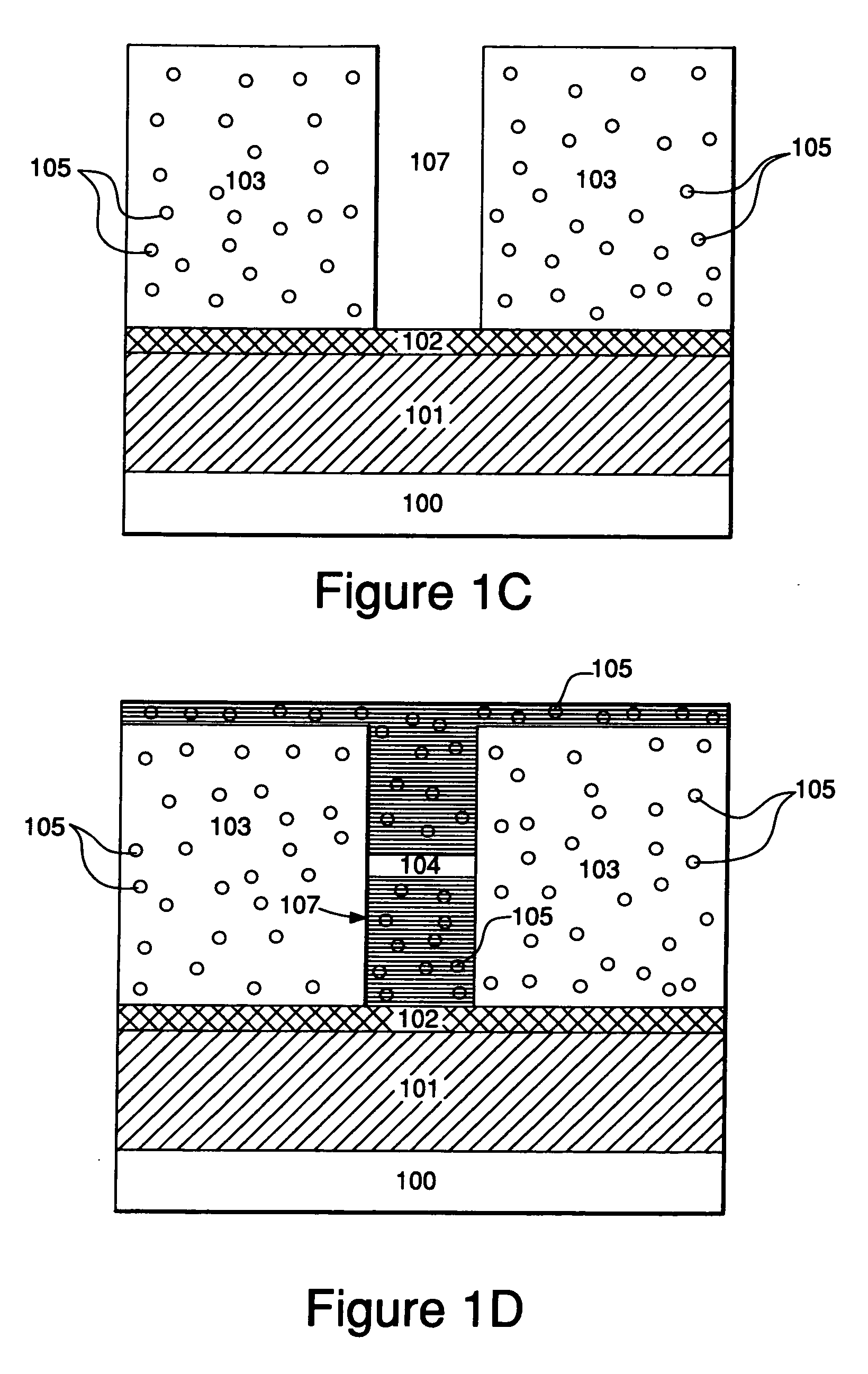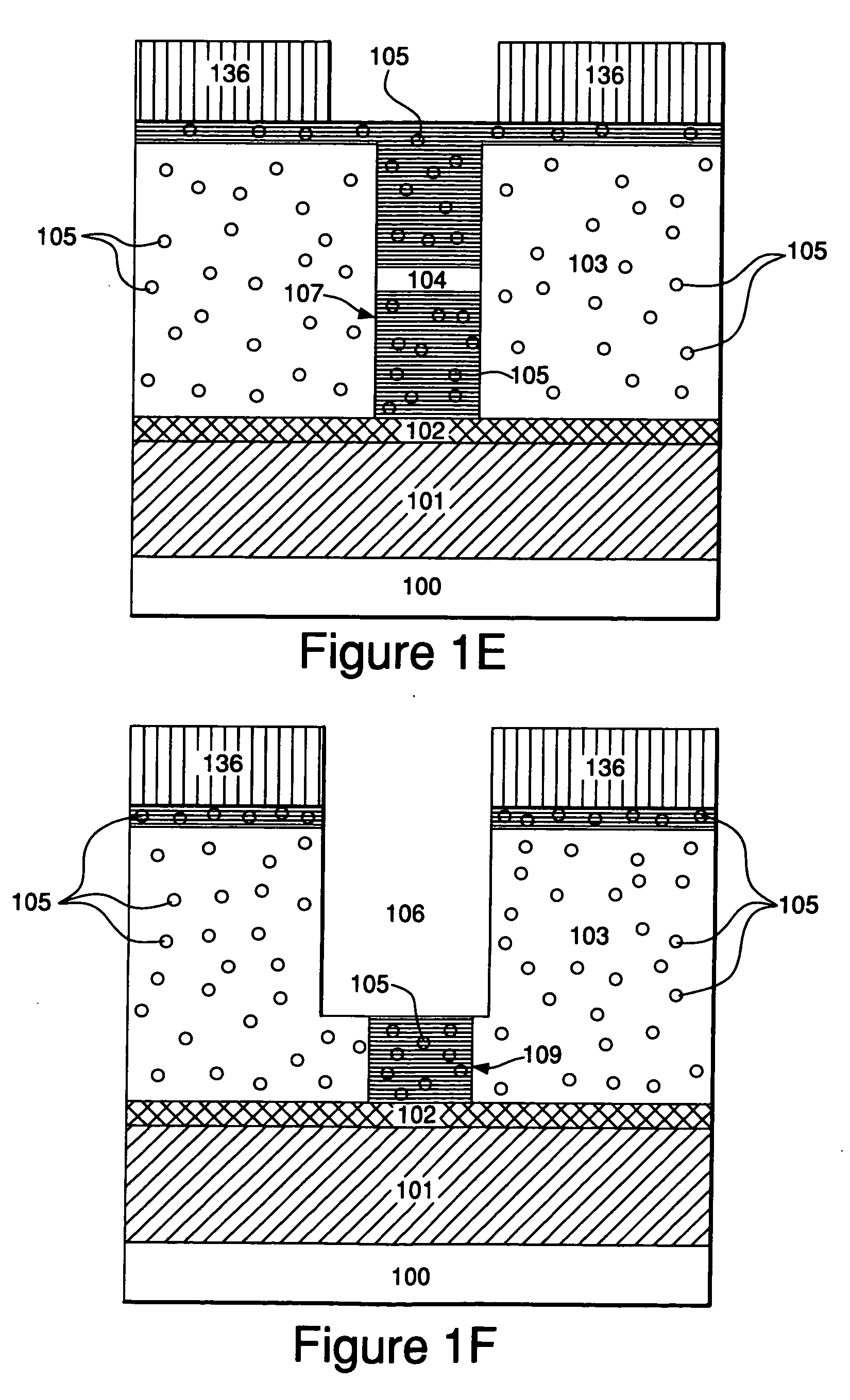Method for defining a feature on a substrate
a technology of feature and substrate, applied in the direction of sidewalk paving, instruments, roads, etc., can solve the problems of difficult to meet escalating requirements, new challenges in the manufacture of devices with smaller feature sizes, and copper (cu) presents challenges to precise patterning and etching
- Summary
- Abstract
- Description
- Claims
- Application Information
AI Technical Summary
Problems solved by technology
Method used
Image
Examples
examples
[0077] In examples 1-3, the thickness and refractive index of each film were measured on an SCI Filmtek 2000 Reflectometer. Dielectric constants were determined using Hg probe technique on low resistivity p-type wafers (<0.02 ohm-cm). Mechanical properties were determined using MTS Nano Indenter.
[0078] In some of the following examples, UV exposure was performed using a Fusion UV model F305 ultraviolet lamp. The films subjected to UV exposure were placed in a 2″ diameter quartz glass tube with sealed end caps. In examples involving a vacuum or inert atmospheres, three pump and purge cycles were performed prior to UV exposure to ensure that any oxygen present was removed from the process tube. Exposure times varied between 0 and 30 minutes.
[0079] In examples 4-5, the thickness of each film were determined by spectroscopic ellipsometry using a variable angle spectroscopic ellipsometer, Model SE 800 manufactured by Sentech Instruments GmbH, and calculated by SpectraRay software. The ...
examples 1 , 2
Examples 1, 2, and 3
PECVD Deposited Films
[0080] Exemplary PECVD films were deposited using an Applied Materials Precision-5000 system in a 200 mm DxZ vacuum chamber that was fitted with an Advance Energy 200 rf generator and using an undoped TEOS process kit. The PECVD process involved the following basic steps: initial set-up and stabilization of gas flows deposition, and purge / evacuation of chamber prior to wafer removal. Exemplary films 1 were deposited using the precursor diethoxymethylsilane (DEMS) with carbon dioxide as carrier gas. Exemplary films 2 were deposited using the precursors DEMS and alphaterpinene (ATP) as the porogen along with carbon dioxide as carrier gas. In Exemplary films 3, the as-deposited films containing DEMS and ATP was exposed to UV light at a pressure of less than 1 torr for 10 minutes to at least partially remove the ATP contained therein. The temperature of the film reached approximately 400° C. during the exposure.
example 4
Spin-On Deposited Films with Dielectric Constant of Approximately 2.2
[0081] Silica sources 22.5 g of tetraethylorthosilicate (TEOS) and 22.5 g of methytriethoxysilane (MTES) are mixed together. 100 g of propylene glycol propyl ether (PGPE) and 9.7 g of Triton X-114 are added to the silica source and mixed thoroughly. In a separate container, 24 g of 0.1 M nitric acid (HNO3) and 1 g of 2.4 wt % tetramethylammonium hydroxide (TMAH) are combined and mixed thoroughly. While the silica source solution is mixing, the HNO3 / TMAH solution is added. The entire solution is mixed for 1 hour. Typically, the solution is then aged at room temperature for one day before the solution is filtered through a 0.2 micron Teflon filter. The solution is then deposited onto a Si wafer spinning at 500 rpm for 7 seconds followed by accleration to 1800 rpm for 40 seconds. The film prepared via this method is then cured in air at 90° C. for 90 seconds, 180° C. for 90 seconds, and 400° C. for 3 minutes.
PUM
| Property | Measurement | Unit |
|---|---|---|
| wavelengths | aaaaa | aaaaa |
| wavelengths | aaaaa | aaaaa |
| wavelengths | aaaaa | aaaaa |
Abstract
Description
Claims
Application Information
 Login to View More
Login to View More - R&D
- Intellectual Property
- Life Sciences
- Materials
- Tech Scout
- Unparalleled Data Quality
- Higher Quality Content
- 60% Fewer Hallucinations
Browse by: Latest US Patents, China's latest patents, Technical Efficacy Thesaurus, Application Domain, Technology Topic, Popular Technical Reports.
© 2025 PatSnap. All rights reserved.Legal|Privacy policy|Modern Slavery Act Transparency Statement|Sitemap|About US| Contact US: help@patsnap.com



